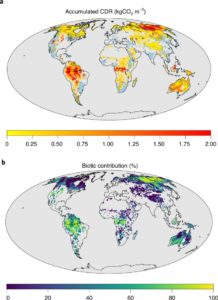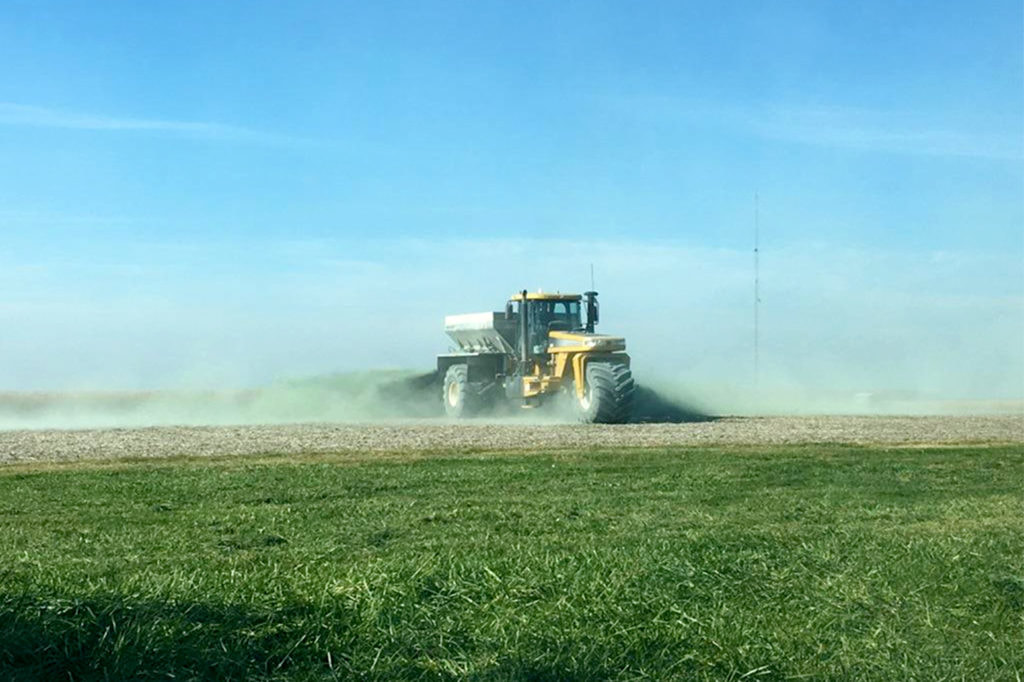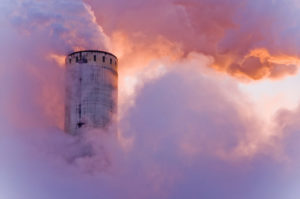Make Climate Goals Attainable: Remineralize croplands
A truck spreading rock dust on a field. Photo by Ilsa Kantola, University of Illinois Champaign-Urbana
Paris Climate Agreement metrics are just out of reach
As of July 2021, the top 10 fossil carbon emitting nations are failing to meet their 2030 green-house gas (GHG) reduction goals, as pledged under the Paris Agreement. The Paris Agreement defines a hard warming limit to 2°C, but current status quo climate initiatives – even if met – will lead to a global warming of 2.6 – 3.1°C. Heating of this magnitude could set forth a cascade of irreversible effects. The Earth, and the communities it supports, are in crisis.
To make climate goals attainable and stabilize the climate, these carbon culprits must adopt more than a decarbonization strategy – they need to actively remove CO2 from the Earth’s atmosphere. These nations have the highest potential to do just that, and fortunately, the science exists for such a promising strategy to become a commonplace measure.
break
Thinking bigger: Transitioning ERW from the micro to the macro levels
For example, China could reduce its CO2 emissions by 5-10% more than it currently pledges, while India, France, and Spain could each reduce their emissions by an additional 40%. Remarkably, enhanced weathering alone could fulfill 100% of Brazil’s pledged CO2 reductions by 2030, largely due to its amenable tropical climate conditions.RTE
A group of researchers across the globe recently published a theoretical article outlining the predicted effects of CO2 removal using enhanced rock weathering (ERW). An understated methodology that may just be the holy grail of geoscience potential, this technique efficiently and effectively mimics the natural rock weathering process. While natural weathering tends to take thousands of years, ERW involves artificially crushing silicate rocks into a fine rock dust that can be applied to available land.
The power of rock dust has been well-documented, both in the lab and in the field. When powdered rock from ERW is applied to ecosystems, the environment flourishes: soil pH stabilizes, soil fertility improves, and crop yields rise.
But rock dust’s ecological prowess is not limited to the soil; when powdered rock enters the ecosystem, it works with the Earth to capture CO2 from the atmosphere and store it in the ground for decades.
While small-scale applications have shown the strength of this technique as a carbon sequestration (i.e. carbon storage) method, rock dust application on a large-scale has not yet been studied and is only in its nascent stages.
To approximate the potential scale of ERW benefits, scientists have turned to theoretical methods that model (or predict) the effects of rock dust on a global level.
break
Modeling global carbon dioxide reduction potential using ERW

Geographic locations of predicted CDR potential after a one-time application of rock dust, 50 years later. Red regions indicate areas with the highest CDR potential. Figure from Goll et al., 2021.
Dr. Goll and a team of scientists generated a theoretical model to investigate the plausibility of large-scale carbon dioxide reduction (CDR) in basalt dust application. Researchers were specifically interested in the theoretical potential of basalt rock, which is known to have several chemical properties that make it a useful candidate for ERW and subsequent CDR.
The model results suggest that a one-time application of rock dust could drastically reduce atmospheric CO2 each year for 50 years. If rock dust is applied to available cropland with high CDR potential, researchers estimate that as much as 125 gigatons (Gt) – or 125 billion tons – of CO2could be withdrawn after five decades.
To reach this measure, rock dust would need to be applied to the surface area equivalent to all of Asia and Africa. While the scale of application may seem extreme, researchers stress that a single, one-time application of rock dust would be needed to reach the maximum CO2 reduction.
If this estimate is correct, Debbie Patskowski – geoscientist and science writer at Remineralize the Earth – calculated that applying 2 tons of rock dust per acre could sequester 1 ton of carbon that is typically sequestered by re-forested land.
Researchers emphasized that their model was based on regions that were sparsely populated and had promising CDR potential, such as in the U.S., China, and India. Even so, they suggest that this estimate is conservative and likely to improve as technology, policy, and public discourse change.
break
The onus is on us: Using ERW to reach national CO2 reduction goals
In a 2020 Nature paper, Dr. Beerling and his team estimated the CDR capacity and costs for land-based ERW implementation for the world’s largest carbon emissions culprits – China, U.S.A., and India. They predicted that adopting ERW could drastically improve the feasibility of their Paris Agreement pledges.
For example, China could reduce its CO2 emissions by 5-10% more than it currently pledges, while India, France, and Spain could each reduce their emissions by an additional 40%. Remarkably, enhanced weathering alone could fulfill 100% of Brazil’s pledged CO2 reductions by 2030, largely due to its amenable tropical climate conditions.
This theoretical result is promising, but it is only one piece of the jigsaw. Rock dust has the potential to sequester billions of tons of CO2 from the atmosphere, but this potential is conditional: the availability of cropland, economic cost, and governmental cooperation are critical issues that must be assessed.
break
Economic costs of CO2 removal using ERW
Researchers estimate that to reach the target of 2.5 Gt CO2 removed per year (for over 50 years) using ERW, countries would (on average) spend up to $500 per ton of CO2. If the goal was to remove 0.2 Gt CO2 per year, the price could be as little as $100 per ton of CO2.
To put these economic estimates in perspective, carbon costs about $100-150 per ton of CO2 (as defined by the World Bank). Critically, research suggests that costs per ton of CO2 removed by ERW are generally equivalent to the cost of carbon. Therefore, a carbon price of $100-150 per ton of CO2 would cover most of the ERW costs for the key nations featured in both articles. In other words: to be carbon-negative would be economically-neutral.
break
Let’s stabilize the tipping point
Researchers also stress that these are conservative estimates. Given the accelerated pace of technological change and innovation, these costs will likely diminish in the coming years.

UN climate change conference took place in October 2021, in Glasgow, Scotland. World leaders met to discuss the climate crisis, and future policy changes.
Theoretical modelling is the first step in transforming small-scale scientific research into large-scale data collection, and these early results are promising. The CDR potential across the globe emphasizes ERW as a feasible, long-term solution to climate change. Even in the short term, adopting rock dust on a local and global level can help nations meet their Paris Agreement goals. But these goals should not be an endpoint – they need to be a starting point.
This leaves the scope of policy change an open question: Can governments, policymakers, and society catch up to science? We are currently standing on a precipice, and the time for action is now.
break
Meghan Wilcoxon is currently a doctoral student studying cognitive science at Brown University. She was a winner of the Hyundai Visionary Challenge for 2018-2019. She is a Quantitative Researcher and Analytical Writer for the Brown University Virtual Environment Navigation Lab.
break
References
- Beerling, David J., Euripides P. Kantzas, Mark R. Lomas, Peter Wade, Rafael M. Eufrasio, Phil Renforth, Binoy Sarkar et al. “Potential for large-scale CO 2 removal via enhanced rock weathering with croplands.” Nature 583, no. 7815 (2020): 242-248.
- Goll, Daniel S., Philippe Ciais, Thorben Amann, Wolfgang Buermann, Jinfeng Chang, Sibel Eker, Jens Hartmann et al. “Potential CO2 removal from enhanced weathering by ecosystem responses to powdered rock.” Nature Geoscience 14, no. 8 (2021): 545-549.
Support us on Patreon
Thank you for joining us today! Please become a member of RTE and support us on Patreon. Unlike many larger organizations, we work with a team of determined and passionate volunteers to get our message out. We aim to continue to increase the awareness of remineralization to initiate projects across the globe that remineralize soils, grow nutrient dense food, regenerate our forests’ and stabilize the climate – with your help! If you can, please support us on a monthly basis from just $2, rest assured that you are making a big impact every single month in support of our mission. Thank you!










Got something to say?